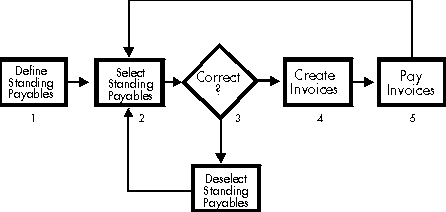Documentation >
MAC-PAC Reference Library >
Financials >
Accounts Payable >
Key Concepts and Procedures >
Standing Payables
Standing Payables
Standing payables allow you to define invoices that are entered or created regularly, for the same amount each time. A typical example of a standing payable is rent, where the same amount is paid to the same vendor each month. The basic steps involved in defining and processing a standing payable are shown in the figure below.

Processing Flow for Standing Payables
These steps are explained below:
1. Define the standing payable using the Standing Payable Entry and Maintenance conversation within Accounts Payable. When you define the standing payable, you must specify information such as the vendor who will be paid, the paying company/location, and the amount to be debited from each affected account/center.
2. Select standing payables for invoice creation. The Standing Payables Selection conversation is used to perform this step. You can select individual standing payables or select all standing payables that meet certain criteria.
3. Verify that the correct standing payables were selected. The Selected Standing Payables Selection Report can be used to perform this step. If necessary, you can use the Standing Payables Deselection conversation to "deselect" any incorrectly selected standing payables.
4. Select the Standing Payable Invoice Creation menu option to submit the batch job. This job will create one invoice for each selected standing payable.
5. Pay the resulting invoices in the same way that you pay other invoices. For more information, refer to the Payment Processing key concept.
Related